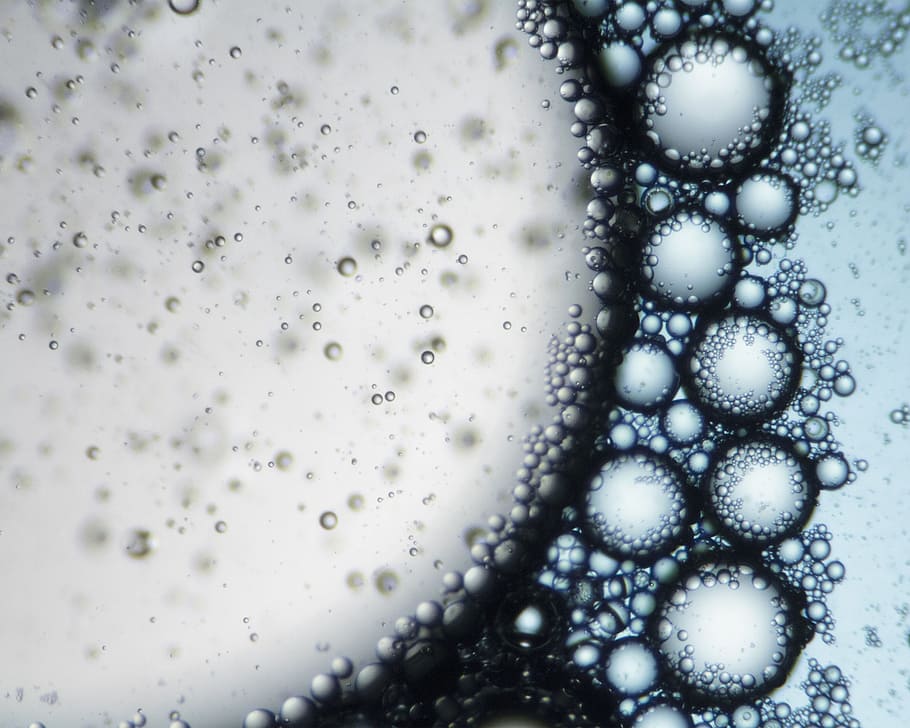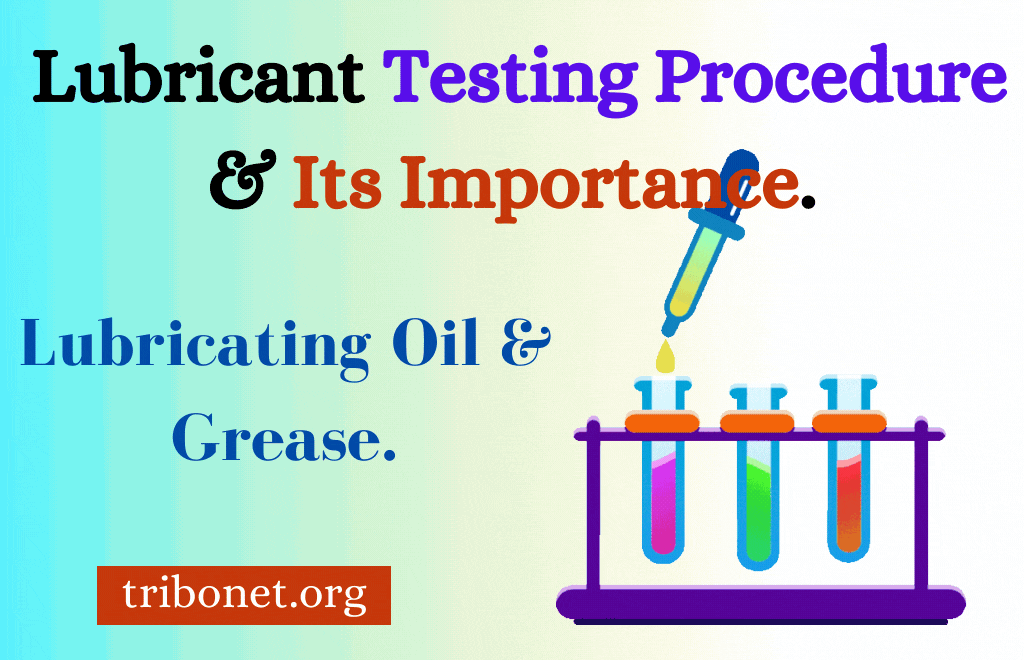The article is written by Riya Veluri, an editorial team member of Industrial Lubricants. After her graduation, Riya works as a website developer & SEO specialist in Lubrication & Tribology Industry & writes technical articles on Lubricants, Lubrication, Reliability & sustainability.
Lubricant Testing
Table of Contents
Different Lubricant Testing Procedures & Its Importance
Have you ever visited a doctor & doctor asks you to have a blood test done? Doctors do that usually because blood tests can tell a lot more about your health. In the same way lubricant testing like oil analysis or grease analysis, can tell your soo much about the health of machinery like engines, compressors, turbines, gearboxes, pumps & all other application where lubricants are used to reduce friction.
Why do you need to test a lubricant?
Because lubricant is the lifeblood of machinery, if something unusual happening in the system or application, it will show in the lubricant & can detect the issue with proper lubricant testing. Things like lubricants additive concentration, contamination, wear metals & viscosity. Lubricant analysis can be a routine activity to prevent sudden premature failure or any machinery problem. And the easiest method & first step to do lubricant analysis is to take some sample of oil or grease from the machine & send it to the lubricant analysis laboratory for testing. In this modern era, lubricant analysis sensors can be installed right on the machines to get real-time information. The lubricants analysis program aims to verify that a lubricated machine is operating according to expectations. When an abnormal condition or parameter is identified through lubricants like oils & grease analysis, immediate actions can be taken to identify the root cause or mitigate a developing failure.
Three main categories of lubricant analysis
Lubricants Properties: This type of analysis focuses on identifying the lubricant’s current physical and chemical state and defining its remaining useful life (RUL).
Contamination: By doing lubricant contamination analysis, we can detect the presence of destructive contaminants, and by narrowing down their probable sources (internal or external), we can identify the probable root cause of machine failure.
Wear debris: This form of analysis is about determining the presence and identification of particles produced due to mechanical wear, corrosion or other machine surface degradation.
Lubricants Testing Procedures
Stribeck Curve Test: In this test, a lubricant performance with respect to friction is assessed. The test typically starts from low speed and proceeds with increasing speed. The friction is recorded. More details about Stribeck test can be found in this article and a video below:
Viscosity Test: To check oil’s viscosity, at first one should understand the definition of viscosity. Viscosity characterizes fluids resistance to flow. Liquids that are resistant to flow or flow slowly has high viscosity. These are liquids like honey sunscreen and dish soap liquids that are not resistant to flow or flow fast have low viscosity. These are liquids like water in vegetable oil.
There are two notations used for viscosity:
1. Dynamic viscosity: Dynamic viscosity is also known as absolute viscosity. The SI physical unit of dynamic viscosity (μ) is the Pascal-second (Pa s), identical to 1 kg m−1 s−1. The physical unit for dynamic viscosity in the centimetre gram second system of units (cgs) is the poise (P). It is more commonly expressed, particularly in ASTM standards, as centipoise (cP).
2. Kinematic viscosity: Kinematic viscosity is the ratio of dynamic viscosity to density. Kinematic viscosity has SI units of m2 s−1. The physical unit for kinematic viscosity is the stokes (St), named after George Stokes. It is sometimes expressed in terms of centistokes (cS or cSt); 1 stokes = 100 centistokes = 1 cm2 s−1 = 0.0001 m2 s−1.
Ways to Measure Viscosity (see the details here)
- Capillary Viscometer
- Zahn Cup
- Falling Sphere Viscometer
- Vibrational Viscometer
- Rotational Viscometer
Acidity and Alkalinity: Unused and used lubricants may contain acidic constituents as additives. The relative amount of these materials can be determined by titrating with bases. The acid number is used as a guide in the quality control of lubricating oil formulations. TAN (Total Acid Number) is also sometimes used as a measure of lubricant degradation in service. TAN is a measurement of acidity determined by the amount of potassium hydroxide in milligrams needed to neutralize the acids in one gram of oil and expressed in mgKOH/gm. It is an important quality measurement of crude oil.
Ph & TAN Test: The pH and TAN test methods measure different aspects of the oil’s acidic or alkaline character. The pH test method measures the apparent pH of the oil, which considers the amount of Strong and Weak Water Soluble Acids, while TAN is a non-aqueous method of determination. Therefore, not necessarily every time TAN is higher, the oil should be corrosive. In other words, mere absolute TAN value cannot indicate the corrosiveness of the oil. Instead, it should be read across with other indicators of oxidation like rising in viscosity, depletion of additive elements, the appearance of oxidation peak in FTIR graph etc.
In standards like DIN 51517, there is no definite value of TAN as specification, and initial TAN needs to be tested and reported for record and condition monitoring.
Grease Oil Separation Test: The test method is used to determine the tendency of lubricating grease to separate oil at an elevated temperature.
The weighed sample is placed in a cone-shaped, wire cloth sieve, suspended in a beaker, and then heated under static conditions for the specified time and temperature. The separated oil is weighed and reported as a percentage of the mass of the starting test sample.

Shell Roll Stability Test: The test method evaluates changes in the consistency, as measured by cone penetration of lubricating greases when worked in the roll stability test apparatus.
Cone penetration of approximately 50-g of lubricating grease is determined. Grease is subjected to low shear at a specific temperature for predetermined time duration in a standard roll stability apparatus; cone penetration is again measured for sheared grease in the test apparatus. The difference between the cone penetration before & after working is used to measure the effect of low shear working on grease consistency.
Four-Ball Weld Load Test: The test method is to evaluate the load-carrying properties of lubricating fluids.
The tester is operated with one steel ball under load rotating against three steel balls held stationary in the form of a cradle. Test lubricant covers the lower three balls. The top ball is rotated at 1440 rpm against the lower three-ball for 1 minute at room temperature. Series of tests are made at increasing loads until welding occurs.
SRV Constant Load Test: To determine lubricating grease’s coefficient of friction and its ability to protect against wear when subjected to a high-frequency, linear-oscillation motion under a prescribed test load.
Oscillation Friction Wear Test: Determination of the fretting and tribo corrosion of lubricants, coatings and plastics subject to constant load and oscillating sliding movements.
Roll Stability Tester: Determination of the mechanical stability of lubricating greases; determination of the oil separation; change inconsistency.
Flashpoint test: Flashpoint testing is a method designed to determine whether a sample mixture of steam and air is explosive. It can determine the temperature at which combustion occurs in a sample. The lowest temperature at which vapours are ignited from the ignition source is the flashpoint of an element.
Foaming Characteristics test: Foaming Characteristics Tester is suitable for determining the foaming characteristics of lubricating oils at 24℃ and 93.5℃. Means of empirically rating the foaming tendency and the stability of the foam are described.
Oxidation stability Test: Oxidation stability is measured by the propensity of oils to form sludge and acid products during oxidation. This test method applies to new oils, both uninhibited and inhibited, but is not well defined for used or reclaimed oils. … No other units of measurement are included in this standard.
Cloud & Pour point Test: Cloud point and pour point are indicators of the lowest utility temperature for lubricants. The highest temperature at which haziness is observed (cloud point) or the lowest temperature at which movement of the oil is observed (pour point) is reported as the test result.
Water Separability Test: Lubricating oil to separate from the water and prevent emulsification is an important performance feature for water pollution and turbulence applications. Water splitting is determined by mixing equal amounts of water and samples at a controlled temperature to form an emulsion and observe the time required for the emulsion to separate. This method is suitable for petroleum oils and synthetic liquids.
Rust Preventing Characteristics Test: The rust resistance properties test (ASTM D665) is designed to measure the ability of industrial oils to prevent rust in water pollution situations. The test can be done with distilled water or synthetic seawater.
Dielectric Breakdown Voltage Test: A dielectric breakdown voltage test measures the electrical stress that insulating oil can withstand without breakdown. This voltage is increased until the oil breaks down until a spark passes between the electrodes. The test voltage is then immediately turned off.
Particle Counting Test: Particle counting is used to monitor the solid contamination of new and in-service fluids. Solid contamination sources include solid oxides from surface oxidation inside the machinery, sand and dirt from the environment, worn mechanical seals, filter blow-by and deterioration, and machinery burrs.
Insoluble and Trace Sediment Test: This test method involves determining the oily polymer’s trace amount (less than 0.05% by volume). Since the oil-soluble material produced by the specific solvent is not made as part of the measured sediment, the test method is not applicable in cases where the unaltered oil-soluble material will contribute significantly to the sedimentation.
Conclusions: We have discussed the importance of lubricant testing & the different procedures of lubricant testing helpful to understand the lubricant life. We can also determine which lubricant can do better in any case-specific application. There are many more testing procedures available & sometimes the lubricants testing tolls or machines are costly. But suppose one can understand the benefits of testing & able to figure out the reason for premature failure of any application due to lubricants. In that case, lubricant testing can cost savior for you.
References
- [1] Extreme Pressure Properties of 600 N Base Oil Dispersed With Molybdenum Disulphide Nano Particles, DOI: 10.13189/ujme.2014.020702.
- [2] Tribological properties of castor oil tris(diphenyl phosphate) as a high-performance antiwear additive in lubricating greases for steel/steel contacts at elevated temperature, https://doi.org/10.1039/C4RA09466B.
- [3] Bruker https://www.bruker.com/
Leave a Reply
You must be logged in to post a comment.



Me want to know the selection of lubrication system and quality of lubricants for cane sugar mill
Procedure for testing at site and recommended values